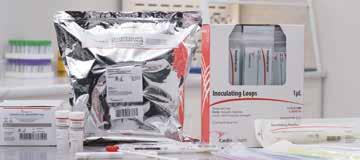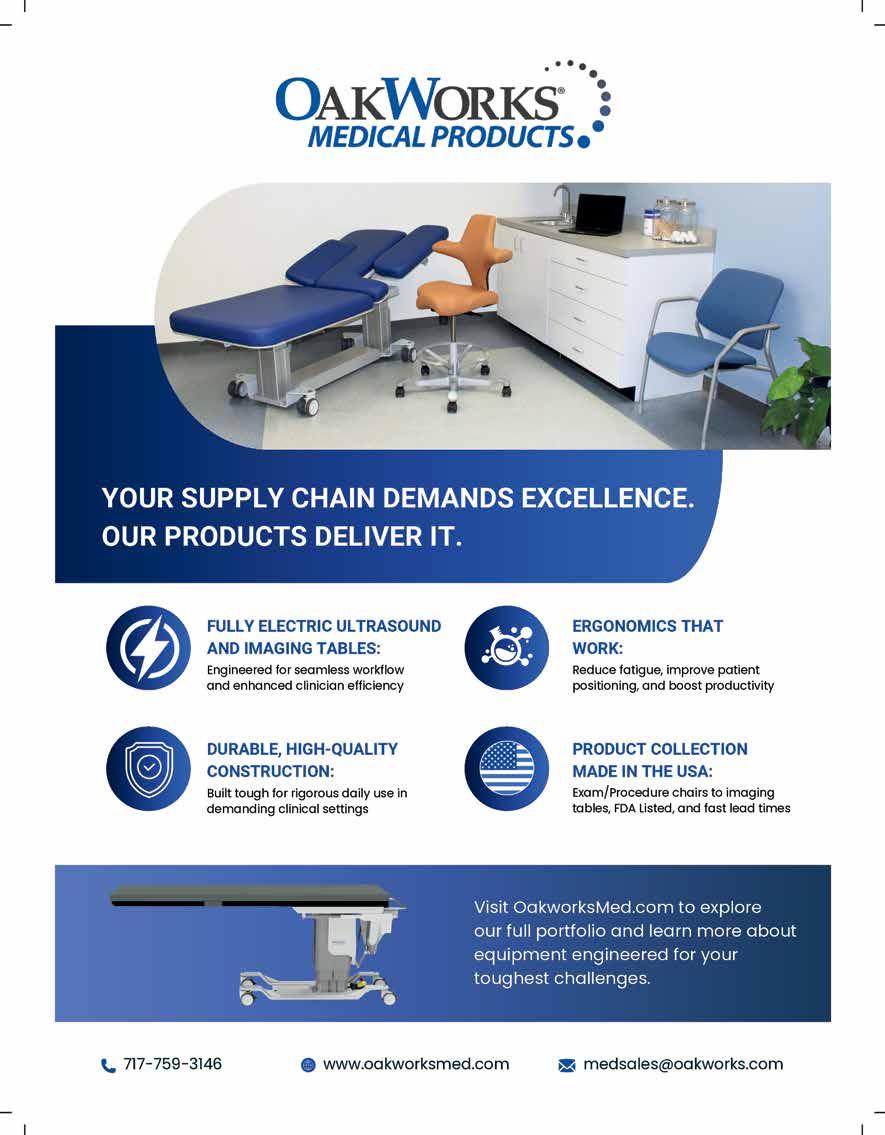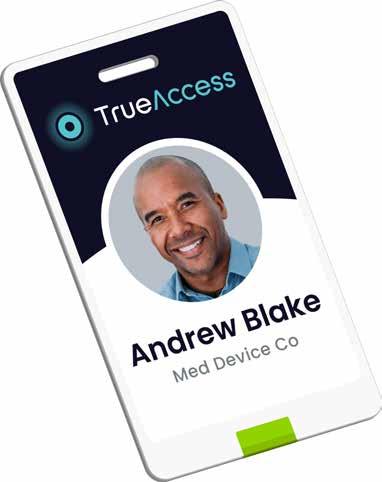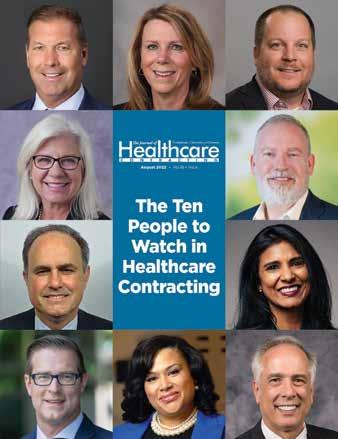

Customer experience stitched with customer service and business acumen
Maintaining balance between demands, expectations and fulfillment drives success.

WHAT A DIFFERENCE OUR DIFFERENCE MAKES.
HealthTrust Performance Group solves the toughest challenges by leveraging our decades of senior level healthcare experience to optimize clinical and operational performance while providing unmatched savings. Its a difference only HealthTrust can make.
2 AI Policy Roadmap
The growing role of AI in healthcare highlights the increasing need for regulations and policy within the industry.
8 The Bottom Line
Tracking financial data in an ambulatory surgery center.
15 Ensuring the Customer’s Right, Rite of Passage
Experience and service are connected, not synonymous.
20 Customer experience stitched with customer service and business acumen
Maintaining balance between demands, expectations and fulfillment drives success.
32 Building Trust, Driving Resilience
How stakeholders can contribute to strengthening the U.S. healthcare supply chain.

The Journal of Healthcare Contracting is published bi-monthly by Share Moving Media
350 Town Center Ave, Ste. 201 Suwanee, GA 30024
Phone: 770/263-5262 FAX: 770/236-8023 e-mail: info@jhconline.com www.jhconline.com
PUBLISHER John Pritchard jpritchard@sharemovingmedia.com
DIRECTOR OF BUSINESS DEVELOPMENT Anna McCormick amccormick@sharemovingmedia.com
EDITOR Graham Garrison ggarrison@sharemovingmedia.com
ART DIRECTOR Brent Cashman bcashman@sharemovingmedia.com
CIRCULATION Laura Gantert lgantert@sharemovingmedia.com
The Journal of Healthcare Contracting (ISSN 1548-4165) is published bi-monthly by Share Moving Media, 350 Town Center Ave, Ste 201, Suwanee, GA 30024.
Copyright 2025 by Share Moving Media All rights reserved.
Please note: The acceptance of advertising or products mentioned by contributing authors does not constitute endorsement by the publisher. Publisher cannot accept responsibility for the correctness of an opinion expressed by contributing authors.
AI Policy Roadmap
The growing role of AI in healthcare highlights the increasing need for regulations and policy within the industry.
Artificial intelligence (AI) has revolutionized the delivery of care across healthcare, providing clinicians with transformative new tools to aid in patient diagnosis and treatment. In fact, nearly 1,000 AI-enabled medical devices have been authorized by the Food and Drug Administration (FDA) within the last 25 years.
To keep up with the rapid pace of technological development, hospitals, health systems, MedTech companies, AI coalitions and more have begun to promote a new era of health technology by advocating for a U.S. policy environment that supports the ethical advancement of these devices.
The Journal of Healthcare Contracting recently spoke with industry experts on artificial intelligence and the need for dynamic policy as the health AI industry continues to evolve.
Regulating AI technology
Healthcare stakeholders have increasingly urged lawmakers to provide clear policy guidelines for the management and use of AI in healthcare, recognizing that regulating the growing use of AI technology in healthcare is essential to ensure patient safety, protect health information privacy, and address ethical concerns.
On the forefront of technologydriven healthcare improvement, Premier Inc. has been working with numerous technologies including artificial

intelligence, machine learning and more for many years, and since 2023, the company has been very involved in AI policy thought leadership.
Premier recently submitted comments on behalf of the White House Office of Science and Technology Policy (OSTP) on the development of an AI Action Plan, which defines priority policy actions to enhance AI leadership within the U.S. while avoiding policies that stifle innovation.
In the AI Action Plan, Premier advises the Administration to prioritize standardized, outcome-based metrics for AI transparency, align federal data standards with industry best practices, require clear labeling of intended uses to prevent misuse of AI algorithms and more.
“Premier has been thrilled to see more conversation happening around the benefits of these technologies and the risks,” said Mason Ingram, senior director of government at Premier.
“Premier views AI as a tool that providers and doctors can use to help with patient care in both visible ways, with the actual provision of care, and in invisible ways to mitigate supply chain shortages or to help predict shortages, to make sure patients are scheduled appropriately and to better navigate
their care,” said Aden Klein, technology policy analyst at Premier.
The Coalition for Health AI (CHAI) also advocates for more explicit AI policy across the industry by bringing together healthcare providers, technology developers, academic researchers, standards bodies, patient advocacy groups, payers, and life sciences/pharmaceutical organizations to create a shared foundation for health AI and its governance.
“CHAI was formed in response to the growing need for clear, consensus-driven guidance and guardrails around the use of AI in healthcare,” according to Merage Ghane, director of Responsible AI in Health at CHAI. “As AI tools began to proliferate, stakeholders recognized that without coordinated guidance and shared infrastructure, we risked both undermining trust and missing opportunities to improve care.”
CHAI’s Responsible Health AI Framework provides a structured approach to evaluating and deploying AI in healthcare settings. It includes a set of consensusdriven guidance and checklists designed to guide developers and implementers in areas like transparency, fairness, safety, usability, and privacy.
The Framework consists of an Assurance Standards Guide which aims to build consensus among stakeholders from different backgrounds, provide a common language for understanding the lifecycle of health AI solutions and best practices for designing and deploying AI within healthcare workflows.
Policy and promoting innovation
A consistent framework for AI development sets industry standards, therefore fostering trustworthy innovation. To
continue to encourage the development of AI, regulatory polices surrounding the technology must remain stable and reliable.
“One of the worst things that can happen to a technology innovator is investing in a first-of-its-kind technology that makes a meaningful difference in patient care, only to have the regulatory framework suddenly change midstream,” said Ingram. “A complete lack of regulations does not necessarily drive innovation; innovators instead want assurance that the rug won’t be pulled out from underneath their investments.”
In response to the need for coordinated efforts around AI in healthcare, organizations have come together to promote more responsible innovation.
AI models being centered around the outputs of those models, as what you put into an AI model quickly transforms the model itself. We’re really interested in making sure model developers are accountable for outputs of their models.”
“The goal of the CHAI framework is to make responsibility operational. That means creating practical tools like testing and evaluation templates, model reporting formats, and risk categorization guidance that health systems, developers, and certifying bodies can use to make informed decisions and ensure safe, effective use,” said Ghane. “Ultimately, the framework aims to reduce friction in procurement and deployment while building public trust and advancing positive health access and outcomes for all.”
“AI models that layer on top of the existing data sources really are the tool that makes a difference in catching health disparities in some of the most vulnerable populations.”
“The success of innovation depends on the adoption, trust, impact, and use of technology, and CHAI emerged to fill this gap by building transparency, accountability, and fairness into the development and deployment of health AI from the start,” said Ghane.
Healthcare stakeholder coordination on the questions surrounding AI is crucial to ensure that the development and deployment of the technology is both consistent and trustworthy.
“Premier’s AI advocacy priorities center around responsible regulatory frameworks that include a call for transparency,” said Ingram. “As a company, we’re passionate about transparency of
AI and improving patient outcomes
One of the many benefits of AI technology to the healthcare industry is its ability to optimize workflows and reduce administrative burdens, ultimately improving care delivery. Streamlined processes enable health systems to enhance patient outcomes and shift their focus toward value-based care.
“One neat thing that AI has the capability to do is go beyond the surface of a patient’s electronic health record (EHR) to look at unstructured data, clinical notes, images from radiology and more to glean things that might not necessarily be captured in the very structured fields of an electronic health record,” said Ingram.
AI is playing a significant role in the healthcare industry’s transition from feefor-service to value-based care models by enhancing diagnostic accuracy, optimizing treatment plans and streamlining operations, all of which reduce health system expenses and improve care quality.
“Premier is passionate about the movement to value-based care, and the use of AI models for improving population health management pairs well with the movement to value-based care,” said Ingram. “When providers and payers are engaged in a value-based care arrangement, all parties have aligned incentives to drive the best outcomes for the patients. AI models that layer on top of the existing data sources really are the tool that makes a difference in catching health disparities in some of the most vulnerable populations.”
is not an afterthought but a core design principle,” said Ghane. “This also comes up when we consider organizations that are better positioned to adopt and use AI solutions, and who have resources to effectively govern these solutions, versus those who could really benefit from these solutions, like smaller payers, community health centers, and rural hospitals, but that may be less resourced and struggle to develop the necessary infrastructure.”
By enabling access to data from diverse patient populations, instead of small data sets from a limited number of patients, physicians are able to expand their clinical capabilities, ensure that models are trained properly and support the ongoing development of AI models.
“It is important that any federal policy or regulatory structure incentivizes model
“ What we want to avoid is every state and local government establishing widely different rules, regulations, and definitions.”
One of the most significant ethical challenges for healthcare stakeholders, however, is ensuring that AI tools don’t reinforce or exacerbate existing health disparities.
“It’s really important to ensure that both the public and private sector make adequate investments in workforce training so that the providers that are learning to use these new technologies in their clinical workflows don’t fall victim to automation bias or accidentally misusing a model for a purpose which it is not well suited,” said Ingram.
“Addressing AI ethics challenges requires careful attention to how models are trained, tested, and evaluated across diverse populations, and ensuring fairness
developers to use robust, high-quality, real-world data to train their models,” said Ingram. “From a data perspective, when considering potential policy levers that can incentivize the integration of AI and a high-quality care, you must focus on model developers using data that’s generalizable to the national population.”
Flexible, but grounded
The effective regulation of healthcare AI requires collaboration across sectors. Consensus driven and layered approaches driven by state, local and national guidelines must create guardrails while maintaining regulatory structures that are
flexible enough to continue to accommodate innovation, said Ghane.
“We’ve been using AI in various forms for many years to improve the healthcare system, and if we can find alignments and correct incentives, we can go farther in improving the patient experience, and the value of care that patients receive,” said Klein. “The push to improve patient outcomes while reducing unnecessary costs in the system is important, and at Premier, we want to see regulations that build on that desire in the health system, providers, and patients.”
“What we want to avoid is every state and local government establishing widely different rules, regulations, and definitions,” said Ghane. “This will hinder scalability for technology developers as well as those adopting these solutions.”
The regulation of AI should provide guidance without hindering innovation, and the effective management of AI technology involves regular reassessment of policy to ensure it is aligned with the evolving needs of the healthcare industry.
“The key is to create regulatory structures that are flexible enough to accommodate innovation, but grounded in clear standards for safety, transparency, usability, security, and fairness,” said Ghane. “Knowing that the resources we are developing include the voices and experiences of those using them is paramount.”
“When we see regulations that create actionable metrics, we introduce really useful data and information that produce useful, quality safeguards for AI technology,” said Klein. “Regulation shouldn’t exist for the sake of regulating; policies should instead have a clear purpose that improve the quality of care.”


Empowering Heart Health: Connecting Diagnostic Cardiology and Vitals Devices










How Well Do Your Systems Talk to Each Other?
With Baxter’s Diagnostic Cardiology Tools and Vitals Screening Solutions, you can send patient data to your EMR.

Scan Here to Schedule a Live Demo Today.










































The AI Lifecycle
Coalition for Health AI unveils 6-Stage Lifecycle for Responsible Health AI Development
Through a consensus driven process, the Coalition for Health AI (CHAI) has developed a 6-stage health AI lifecycle based on industry-standard AI development frameworks. The lifecycle encompasses processes from initial problem identification and solution planning through to large-scale deployment and monitoring of an AI solution and surrounding system (workflows, technical support components, personnel).
Stage 1: Define problem and plan
Healthcare is riddled with “solutions” in search of problems. Responsible innovation requires a clear understanding of the specific issue AI is intended to solve, which will drive the intended purpose of the tool. The intended purpose a) defines the scope of verification & validation activities and b) allows reasonable delineation between user responsibility and vendor responsibility. First, however, an upfront investment of time and effort is needed to map root causes and understand the specific needs of those experiencing the problem(s). Stage 1 focuses on this process, with developer teams conducting surveys, interviews or market research to understand healthcare system needs. In Stage 1, implementer teams also identify a clear problem, its setting, and stakeholders involved (which together comprise a use case), thereby quantifying potential return on investment, return on health outcomes, and improvement of healthcare operations. Implementers use this information to decide whether to build an in-house AI solution, procure one from a third party, or partner with a third party to develop a solution.
Stage 2: Design the AI system
Stage 2 involves capturing details of the AI system of which the solution is the main component. This includes detailing its technical requirements, proposed system workflow, and deployment strategy. The design of the AI system is informed by the business requirements of the health system(s) and the needs of representative end users where the AI solution will be implemented.
Stage 3: Engineer the AI solution
The engineering stage aims to create an AI solution that can accurately predict or classify data and develop the interface for exposing AI solution output, as defined during the Design stage. This stage also ensures that AI solution deployment can be operationalized and that adequate planning is completed prior to deployment. In cases of externally developed AI solutions, the developer should provide expertise in collaboration with the implementer, who ensures that the AI solution meets its intended purpose via risk-benefit analysis before and after deployment.
Stage 4: Assess
This stage involves a series of assessments to determine whether to proceed with a pilot of the AI system in Stage 5. When existing AI technologies are acquired from an external organization, local validation and installation qualification need to be conducted first, prior to the assessment of the AI system as a whole. A change management plan should be in place to delineate who, between the developer and implementer, is responsible for performing these duties. This is followed by a prospective, silent evaluation and the establishment of a risk management plan, based on anticipated risks from Stages 2 through 4. These steps are followed by end user training and usefulness testing, along with a review to ensure compliance with applicable healthcare standards and regulations prior to piloting and deployment.
Stage 5: Pilot
The pilot stage is the first real-world use of the AI solution by the implementer team to inform large-scale deployment plans. Prior to the general deployment of an AI system, careful review and consideration must be made by the health system to decide whether or not to deploy an AI model into production. Based on this pilot stage, success criteria are reviewed to inform the decision on whether to deploy the AI system. Some common success criteria include the AI solution’s accuracy, reliability, interpretability, feasibility, user acceptance, cost, and alignment with the organization’s values and goals. This process is primarily undertaken by the implementer team.
Stage 6: Deploy and monitor
The deployment and monitoring stage is the process of making the AI solution and system broadly available to the healthcare system or relevant specialty. Once deployed by the implementer team, the AI solution is often handed over to a model operations team (when available) to provide ongoing monitoring, retraining, and governance of models to ensure peak performance and that decisions are transparent.
Source: https://chai.org/workgroup/responsible-ai/responsible-ai-guide-raig-and-raig-executive-summary

See what’s possible

Distributors and self-distributing health systems now have complete transparency of their Dukal products’ from purchase order to delivery.
Product Assigned at the Factory Level
Product Tracking at the Item Level
Compatible Excel Reporting
Automated Communication
Worldwide Tracking

Scan

> Learn more at dukal.info/insight
The Bottom Line
Tracking financial data in an ambulatory surgery center.
BY PETE MERCER

In the fast-paced and highly regulated environment of an ambulatory surgery center, tracking financial data is not just a best practice – it’s a necessity for long-term success and sustainability. With rising operational costs and shifting reimbursements, these outpatient facilities are turning to detailed financial data to guide key decisions, from staffing and equipment investments to service expansion. As financial pressures mount, understanding the story behind the numbers is helping these centers balance efficiency with high-quality patient care.
In the following article, Matt Lau, a senior financial advisor for Avanza Strategies and the senior vice president of client accounting and financial services for Avanza parent company MedHQ, talked about what the financial data in an ambulatory surgery center means for the organization and how it can be leveraged to better understand the financial position. Avanza Strategies is an advisory firm devoted to supporting ambulatory surgery centers from concept to launch, providing strategic, consultative feedback to help ASCs put their best foot forward. This is part one of a two-part series where we get a better understanding of how ASCs track and leverage their financial and clinical data.
How financial data impacts ASCs
While financial metrics are typically not used to measure quality or improve patient outcomes in ASCs, it’s important to understand how gathering and reporting that data can impact ASC reimbursements. “The Medicare Ambulatory Surgery Center Quality Reporting (ASCQR) Program requires surgery centers to report specific quality measures,” Lau said. “Failure to meet the program’s clinical reporting requirements can result in a 2% reduction to the ASC’s reimbursement schedule from Medicare.”
One area where the financial metrics can link to clinical outcomes is case costing, the process wherein an ASC determines the direct and indirect costs of a surgical procedure. According to Lau, if case costing can show that a procedure can be done differently while maintaining quality patient outcomes, it is possible to change physician behaviors. This can be a lengthy process, typically managed
by materials managers and OR nurses, but it’s critical for ensuring that an ASC maintains healthy margins.
Through case costing, ASCs can analyze the resources used in specific surgical cases, particularly medical supplies and implants. Lau said that when ASCs compile case costing data on a sufficient number of cases and include the clinical outcomes for those cases, they can compare the specific types of supplies and implants used by different surgeons performing the same procedures. Most billing technology platforms have the capability to track costing data for each case that is performed in the facility.
performance of an ASC, it’s much more difficult to make meaningful changes to any processes that might not be getting the best results.
“Financial reports can highlight key drivers of ASC financial performance,” Lau said. “For example, an income statement trend report that provides the ASC’s financials side by side over time could show that profits started to decrease at the same time anesthesia stipend expense started to increase. The ASC could then discuss ways to reduce the anesthesia stipend costs and implement those operational changes to help improve the bottom line.”
Tools like barcode readers can help ASCs to streamline inventory counts and order supplies, while AI can work to reduce time and errors for processing accounts payable and coding surgical procedures for the facility. Through tools and resources like these ASCs have an opportunity to get deeper insight into the information that matters most.
“If there is a significant difference in costs with the same positive outcomes, this information could help to potentially change physician behaviors concerning their use of supplies and implants and improve the overall financial health of the ASC without sacrificing quality or patient satisfaction,” Lau said.
Why financial data matters
Why is financial data so important? Without a deeper understanding of what the financial data is saying about the
With better insights, it’s easier to make better, more informed business decisions. Measuring the financial results against the expectations of the budget might reveal new insights into revenues and profits that could then correlate with launching new programs (e.g., total joint replacement) for the ASC.
Lau said, “From there, the ASC could implement further changes that would support the growth of the new program. Additionally, comparing the ASC’s financial metrics against industry standards could show that the ASC is spending far more on its labor than
similar ASCs. This revelation could lead to evaluating and changing the employee scheduling process to make it more flexible, efficient, and cost-effective.”
Part of the challenge with understanding why financial data matters is that most ASC employees have a clinical background. On top of that, financial reports can feel extremely overwhelming to people who are not necessarily business oriented. Lau explained that tracking and reporting financial data is a huge responsibility, but it’s critical to understand what your numbers say about the financial health of the business.
“They often have had extensive clinical training and are extremely knowledgeable about taking care of patients. ASCs could not exist without these super smart clinical people, but they may not be as comfortable and knowledgeable when it comes to the financial side of the business,” he said.
Leveraging the latest technology for the future of data tracking
As technology continues to evolve, it allows for new opportunities to streamline processes that used to require a significant amount of time. While automation and AI are still in the early days as far as what these tools are capable of, they can create efficiencies right now that will significantly impact and improve the team.
Lau said, “One area where technology is helping to streamline the process of tracking and measuring financial data is the processing of the ASC’s invoices.” This has traditionally been a lengthy process that involved mailing an invoice to the facility, having someone open the
Key points
Financial data is essential for strategic and operational decisions
Ambulatory Surgery Centers (ASCs) rely on detailed financial data to guide critical decisions related to staffing, equipment, service expansion, and overall sustainability. Accurate financial tracking helps identify performance drivers and supports informed changes to improve margins and operations.
Case costing connects financial metrics with clinical outcomes
By analyzing the direct and indirect costs of procedures (case costing), ASCs can compare surgeon practices and resource use while maintaining patient care quality. This data can help change physician behavior and optimize the use of supplies, ultimately improving the ASC’s financial performance without compromising outcomes.
Technology and AI are streamlining financial processes
Automation and AI are reducing manual workload in areas like invoice processing, coding, and inventory management. These technologies enhance the accuracy and speed of financial reporting, enabling ASCs to make quicker, data-driven decisions and stay competitive in a fast-evolving healthcare environment.
mail, file and manually enter the invoice into the accounting system, and assigning the correct expense accounts before any payment was made.
AI is perfectly suited to simplify complex processes like invoicing, greatly reducing the margin for error and freeing up the rest of the team to accomplish other tasks around the center. “The processing of invoices is becoming much quicker, and the coding of these invoices is more accurate, which then leads to more timely, accurate, and reliable financial reporting.”
Like with everything else, technology is on the frontline of trends that are shaping the future within the ambulatory surgery space. As things like automation and AI take center stage in the next few
years, ASCs will need to be able to adapt to the changing landscape.
Tools like barcode readers can help ASCs to streamline inventory counts and order supplies, while AI can work to reduce time and errors for processing accounts payable and coding surgical procedures for the facility. Through tools and resources like these ASCs have an opportunity to get deeper insight into the information that matters most.
Lau said, “ASCs can utilize tools such as business intelligence solutions and data lakes to collect data from their various systems – like revenue cycle, inventory, payroll, accounting – analyze that data and convert it into meaningful information and actionable insights to facilitate more informed decision-making.”

Your Costs Are Rising — Your Options Should Be, Too
Rising costs and supply disruptions are forcing hospitals to rethink their supply chain management.
Strategic health systems are aligning sourcing with clinical goals, using predictive analytics, and leveraging Premier’s $84 billion in spend and more than 100 billion data points to cut costs without compromising care.
Premier works as an extension of your team to deliver proven, data-driven solutions.
Don’t wait — join the health systems that, even amid uncertainty, are implementing supply chain support options that are optimizing supply chain spend.
Schedule An Assessment
Enabling respiratory season responsiveness through distribution

The annual fall and winter respiratory disease season presents healthcare organizations with the challenge of ensuring adequate access to critical diagnostic tests and treatment supplies. The unpredictable nature of seasonal infections like flu, COVID-19, respiratory syncytial virus (RSV) and Strep A (which while not a respiratory illness has a seasonality that coincides with many respiratory viruses) can lead to erratic demand and supply chain disruptions, making effective distribution and inventory management a top priority for healthcare providers. Without a well-coordinated strategy, providers may struggle to maintain the right inventory of products needed to diagnose, treat and monitor these illnesses, potentially jeopardizing patient care.
Healthcare needs distributors that are more than just box movers
When you choose Cardinal Health, you’re joining a community committed to diagnostic quality and supply chain resiliency. With a dedicated, clinical lab pointof-contact, on-hand capital equipment experts and supportive suppliers (including exclusive relationships), our teams of professionals are all invested in championing your success.
Your priorities are our priorities. That's why we offer competitively priced, quality products that are locally stocked for your convenience. And we’re constantly expanding our portfolio, with over 1,000 product launches across 29 suppliers this year.
We support all testing disciplines, including:
• Anatomic pathology/ histology
• Blood bank
• Capital equipment
• Clinical chemistry
• Coagulation
• Hematology
• Laboratory equipment
• Laboratory essentials
• Microbiology
• Molecular diagnostics
• Point of care & infectious disease
• Research essentials
• Specimen collection
• Specimen collection kits
• Urinalysis
• Virology


We're a preferred laboratory distributor and product advisor to top healthcare providers, and we have been for decades.1 Count on us for financial savings, operational efficiencies and supply continuity through our rich history of distribution excellence, industry-leading lab expertise delivered by a strategic, responsive team of 200 lab professionals and clinically equivalent Cardinal Health™ Brand products.
Transparency without the hidden costs or fees. One point of contact. Deep supplier relationships. Always-on service. That’s the Cardinal Health way.
We are your lab advisor. Expertise. Choice. Efficiency. Savings.
When seasonal illnesses surge, organizations require the same supplies at the same time, leading to widespread constraints, backorders and product allocations. This erratic demand pattern can make traditional forecasting and inventory planning extremely difficult. Adding to this complexity are the downstream effects of inventory uncertainty, such as providers stocking up in anticipation of heightened demand only to have to dispose of excess inventory if the season does not materialize as expected or if products expire before they can be used. Balancing the need to have adequate supplies on hand while avoiding costly waste requires a well-informed strategy that combines a data-driven approach with distribution solutions that drive supply chain resiliency.
The power of data-driven planning
Access to robust historical data enables hospitals and health systems to transform raw information into actionable insights to aid respiratory season planning. Making effective use of this data requires going beyond mere data collection to facilitate true cross-functional collaboration. Bringing together providers, labs, supply chain teams and distributors can help organizations navigate uncertainty by developing a holistic and responsive strategy based on real-time information about supply constraints and product availability.
The Cardinal Health™ Reserved Inventory Program leverages this evolving approach to collaborative supply management. This first-of-its-kind program addresses one of the most critical challenges in respiratory season preparation: consistent access to preferred diagnostic products amid seasonal shortages. Instead of competing for limited resources during
peak demand, providers can proactively secure their essential diagnostic supplies. By working directly with a laboratory sales representative, providers can identify specific product needs and quantities, secure exclusive local access to reserved inventory, receive customized item numbers for dedicated product ordering and access reserved products without additional cost. The program covers a wide range of critical testing assays, including COVID-19 tests, Influenza A and B tests, Strep A diagnostics and RSV testing kits.
Leveraging distribution technology
As a specialized clinical lab distributor, Cardinal Health offers more than just the right products in the right place at the right time. With our comprehensive view of the diagnostic testing landscape, we leverage deep ecosystem knowledge and innovative technology solutions to help organizations develop more tailored and responsive plans during respiratory season and beyond through supply chain strength.
For example, The Cardinal Health™ Innovation Lab demonstrates how advanced technologies can drive supply chain strength to address critical supply chain challenges and improve service to customers. In the 4,000 square foot venue in the Cardinal Health™ Ohio Valley Distribution Center, technology like Autonomous Mobile Robots (AMRs) and Multi-Agent Orchestration (MAO) platforms dramatically improve distribution capabilities by enabling warehouses to pick and pack products quickly and accurately. These modernizations, along with additional automation and cloud-based solutions, are helping Cardinal Health enhance service to customers by improving inventory precision and resiliency.
Driving supply chain resilience
Cardinal Health’s customer-centric approach means continually adapting and investing in new solutions and distribution capacity that helps respond to unpredictable healthcare challenges.
This commitment to supply chain resiliency was recently recognized by the Healthcare Industry Resilience Collaborative (HIRC), which awarded Cardinal Health a Diamond-level Resiliency Badge. As HIRC’s highest possible rating for medical products distribution, the achievement highlights the critical importance and power of robust, adaptable healthcare supply chains in enabling our customers to maintain focus on patient care.
Our recent investments reinforce our focus on driving operational excellence and supply chain resiliency. We are expanding our distribution network with state-of-the-art facilities, including new distribution centers in the Boston area, Northeast and Central Ohio, and Montgomery, New York. These expansions aim to deliver increased inventory capacity and improved ability to meet healthcare providers’ evolving needs.
Collaborating with a distributor that evolves to meet your needs Healthcare leaders who proactively invest in intelligent demand planning, flexible distribution networks and transparent supplier relationships will be best positioned to ensure uninterrupted, highquality patient care during challenging seasonal periods.
By investing in new infrastructure, advanced technologies, and operational efficiencies, Cardinal Health serves lab customers as a reliable distributor during challenging periods like the respiratory season.
Ensuring the Customer’s Right, Rite of Passage
Experience and service are connected, not synonymous.
BY R. DANA BARLOW
Saunter into any of the popular fast-food chains and you’ll likely face an initial choice as the door closes behind you: Either go to the counter to place your order with a human or walk over to one of the freestanding kiosks to place your order electronically. (Yes, a third choice would be to order ahead using the online app on your smartphone, but then that option would detract from the narrative here … or would it? Hmmm…)
You may get to “have it your way;” you may be “lovin’ it,” or you may exclaim, “gimme a break!” in frustration and “just wing it.”
Ordering at the counter certainly is convenient, and for the most part, quick (if the person isn’t still training on how to use the computerized register). Candidly, it seems like people stand at the kiosks a lot longer than they do at the counter – even if they’re reading the familiar menu at the counter and trying to figure out what to eat. Why does it seem like they spend more time at the kiosk than the counter when the kiosk is designed –allegedly – to be more efficient? They’re either trying to figure out how to operate it and the system behind it or they’re investigating all their food options through photos, animation and nutritional data accessible by tactile-sensitive touchscreen or QR code for a comprehensive personal interactive digital experience. Whew!
Now imagine if healthcare supply chain operated like a fast-food franchise or retail outlet equipped with kiosks.
Clinicians can come to the counter or kiosk to order supplies for the OR. Of course, we recognize that the OR doesn’t

come to Supply Chain for this privilege – the opposite is supposed to occur. Supply Chain goes to the OR to provide supplies, or better yet, the supplies magically appear in the area where clinicians expect to find them. If the product is located on the storeroom or warehouse shelves, the clinician is encouraged to leave the drive-through window and “park” in the Supply Chain office waiting room, texting the clerk at the window. Meanwhile, behind the curtain in Supply Chain, staff members scurry around like the motorized carts-on-rails you see in high-density vertical storage examples. For old-timers, think of those “Automat” machines.
Arguably, a supply chain kiosk model may remove some of the human-to-human interaction during a transaction, unless you count asking someone in Supply Chain to help you use the kiosk, calling into question the concept of self-help for shelf-help.
Still, kiosks in fast food and retail establishments are designed to enable and facilitate customization for packaging and product(s), encourage impulse buying and link to loyalty programs to earn discounts, points and other branded swag. Further, the kiosk’s system theoretically connects to “you” and your avatar traveling along the internet superhighway.
Realistically, perhaps none of these options makes sense for healthcare clinicians interacting with Supply Chain. But what if they could? Forget about impulse buying (that’s not the way to cut costs by managing and reducing consumption, right?). Instead, focus on the customization and loyalty aspects. Imagine if the clinician could “customize” a product or service order based on such qualities as the brands under contract or formulary, quantity needed, favored supply chain staffer to deliver, etc. The supply chain kiosk then can “remember” the requisition history of that clinician and enter it into supply chain’s own system, integrated with replenishment, procurement, ordering, billing and so forth.
system. A kiosk-oriented strategy merely offers yet another option, short of clapping your hands, snapping your fingers, sending expressive emails in ALL CAPS or screaming into the telephone at Supply Chain for them to deliver and fulfill your request(s) … like yesterday! STAT!
Rest assured, Supply Chain remains well aware of how demanding the ER and OR can be as well as the nursing floors and other areas – whether the blood-pressure-elevating tension is due to unanticipated, unexpected surges on one side or short-sighted planning (or lack thereof) that motivates those classical but convenient CYA moments.
However, convenience represents one of the central tenets behind the customer experience (CX). A few years back Staples
Imagine if the clinician could “customize” a product or service order based on such qualities as the brands under contract or formulary, quantity needed, favored supply chain staffer to deliver, etc.
Granted, this conceptual kiosk process might compete with the various automated supply cabinets currently in use throughout thousands of healthcare organizations where clinicians directly pull a desired product from a vending machine. This doesn’t necessarily eliminate Supply Chain staff because they must continually replenish those units akin to the “Automat” of yore. Of course, clinicians also can log onto an organization’s intranet via desktop, laptop or handheld device (e.g., a smart phone or tablet) for inventory requests through the integrated enterprise resource planning (ERP)
R. Dana
introduced its trademarked “Easy” button under the tagline, “Get in, get what you want, get out.” Isn’t that what we all want? Unfettered and immediate access to abundantly available products at the lowest possible prices? Imagine our CX if we could produce what we needed via a personal 3-D printer enroute to one of those Star Trek replicators aboard the U.S.S. Enterprise. Just ignore the prospect of these systems breaking down or malfunctioning.
Alas, we’re lightyears from both – more legally than technologically – so Supply Chain has to make the CX for clinicians as well as administrators, guests and visitors
to the healthcare facility as convenient as possible with cost-effectiveness looming in the background, accented with a sincerely beaming smile that radiates warmth (even if it’s fueled by the boiling rage inside).
What’s important to note, however, is that CX as a concept is not necessarily interchangeable nor synonymous with the term customer service. One begets, contributes to or leads to the other. Customer service is what’s given; customer experience is what’s perceived and received. Suppliers and vendors control the former and interpret the latter; buyers and consumers define the latter based on their interpretation, perception and reception of the former.
CX includes customer service through which the oft-quoted “right product in the right place at the right time in the right quantities at the right price” seems to drive most efforts. But … there’s more! You must add in the expected “bedside manner” principles of comfort, friendliness, helpfulness, personality and positive attitude.
All of this must feel genuine in front of the irritable and irritating customer, not faked or forced until the transaction is completed so you can let your internal beast gurgle to the surface to vent among your colleagues.
In short, CX can be classified or deemed a success if the customer actually wants to see you again rather than just needing to see you again, regardless of what transpired during the most recent conversation or transaction.
Supply Chain likely will agree that it’s fine to be needed, but much better to be wanted – for positive and uplifting reasons.
serves as a senior writer and columnist for The Journal of Healthcare Contracting. Barlow has nearly four decades of journalistic experience and has covered healthcare supply chain issues for more than 30 years. He can be reached at rickdanabarlow@wingfootmedia.biz
Barlow

The reason our IV bags aren’t made with DEHP is clear.
Over 40 years ago, B. Braun recognized the environmental and patient risks of toxic chemicals like DEHP and PVC and was the first medical device manufacturer to remove them from many products. DEHP, which is used to soften PVC, can leach into IV fluids, potentially putting patients at risk. Protect your patients and the planet with a full line of IV bags not made with DEHP or PVC.
Cardinal Health™ Lab Distribution: Products and Services
Cardinal Health™ Brand products at a savings
Anatomic pathology products including:
• AP storage
• Biopsy bags
• Cassettes
• Clearing agents
• Cover glass
• Cytology supplies
• Dehydrants
• Embedding materials
• Foam biopsy pads
• Formalin
• Formalin neutralizing pads
• Freeze spray
• Microtome blades
• Paraffin
• Paraffin dispensers
• Prefilled formalin containers
• Slide mailers
• Slides
• Tissue baths
• Tissue marking dye
Blood bank and hematology products including:
• Blood bank saline
• Hematology consumables
• Hematology reagents
• Plasma thawing bath and accessories
Clinical chemistry products including:
• Beta-hydroxybutyrate assays
• Sample cups
• Single-release drop blood dispenser
• Wright stain (bulk and stain packs)
Lab equipment products including:
• Centrifuges
• Freezers
• General lab equipment
• Incubators
• Lab furniture
• Lab weighing
• Blue plug caps
• Refrigerators
• Ultra-low freezers
With a broad and deep portfolio like ours, you don’t have to worry about finding the right lab products for your organization. And, Cardinal Health™ Brand laboratory products are clinically equivalent to leading national brands, so you get savings without sacrificing quality.




Lab essentials including:
• Glucose tolerance beverages
• Lab chemicals
• Lab labels
• Lab liquid handling
• Lab racks
• Lab supplies
• Lab tape
• Lab temperature monitoring
• Lab timers
• Labware
• Test tube closures
• Test tubes

Microbiology products including:
• Collection swabs
• Gram stainer supplies
• Loops
• Microbiology supplies
• Needles
• Stool collection
• Transport swabs

Point of care products including:
• Crypto giardia testing
• H.pylori testing
• HCG testing
• Influenza testing
• Mono testing
Specimen collection products including:
• Blood tubes
• Lancets
• Specimen bags
• Specimen containers
• Specimen cups
• Strep A testing
• Urinalysis testing

• Tourniquets
• Tube holders

Labs rely on a distributor that’s more than just a box mover. Count on Cardinal Health to provide financial savings, operational efficiencies and supply continuity through our rich history of distribution excellence and decades of lab expertise.
True transparency means no hidden costs or fees. One point of contact. Deep supplier relationships. Always-on service. That’s the Cardinal Health way.
©
Customer experience stitched with customer service and business acumen
Maintaining balance between demands, expectations and fulfillment drives success.
BY R. DANA BARLOW
A wise(acre) supply chain executive at a prominent East Coast integrated delivery network (IDN) once noted that the team knows when it’s doing a good job if the telephone isn’t ringing from an internal line and the emails aren’t piling up.
Some may define customer experience as the feeling they get when you give them what they want. Others may add the brusque “within reason” to those demands. Still others may classify it as providing people with what (you think) they need.
For supply chain, the sweet spot may reside within the intersection of those three circles.
What’s noteworthy? None of the three makes absolutely everyone happy, so the goal may be to provide as much balance as possible by optimizing decisions. This may involve playing the long game to develop trust and mitigate results, according to healthcare supply chain executives.
Within the pressure-cooker healthcare environment, however, some may find waiting patiently for something or someone a bit of a challenge.
Defining customer experience (CX) varies. For some, it’s availability, breadth and depth of product choices. For others, it’s a friendly face and/or a calming voice that assures them that they’re in good hands and shape.


Some rally around the banner of “customer centricity,” as in putting the customers first by anticipating needs, predicting market demands and maintaining a position ahead of customer expectations. It may be magic, it may be chance, or it may be driven by automation in the form of artificial intelligence (A.I.) or decisionsupport software.
The overarching premise may be to find balance between the demands of customers and that of the supply chain to meet in the middle and move forward together. Or does supply chain need to be at least one step ahead as much as possible – versus two steps back?
and preventive care when, where and how they need it.
“Supply Chain supports this vision by ensuring we act as an ally with our care partners through the assurance of products and services, especially those that are directly or supporting this access to care,” Lubotsky continued. “This customer experience heavily depends on our products being delivered on time and in full when they need it. If we are addressing specific clinical services agreements that support patient care, then the specific service level agreements (SLAs) define the customer experience needed to support patient care properly. For capital equipment, the
Service may mean visibility to status – like where is my contract? – to performance of the function – like driving the lowest possible price for the selected product or service.
Definitive dilemma
CX can mean different things to different people within a seemingly unified group –say, supply chain. Each executive, leader, manager and professional harbors his or her delineation between what it is and what it is not. None is wrong; they’re all right – to an extent.
“The term ‘customer experience’ takes on different definitions based on the types of products and services,” Tom Lubotsky, vice president and Chief Supply Chain Officer, Allina Health, Minneapolis, told The Journal of Healthcare Contracting. “At the end of the day, our primary customer is the patient or consumer of our healthcare services. At Allina, we wish to be our community’s most trusted health ally by providing access to specialty
reliance of keeping equipment functioning at all times is essential and hence the customer service of fulfilling uptime rates is critical.”
Steve Downey, vice president, Chief Supply Chain & Support Services Officer, Cleveland Clinic, classifies CX based on the role Supply Chain plays in the overall healthcare enterprise, which extends beyond the organization itself.
“We are a shared service for the enterprise, in the end serving the patients,” Downey indicated. “Our stakeholders are the executive team, hospital operations, caregivers and fellow operations team members that need our services. Those customers interface with us from their own lens, which may include the full range of supply chain functions. Service
may mean visibility to status – like where is my contract? – to performance of the function – like driving the lowest possible price for the selected product or service. It may also include overall management of the supply chain and delivering it using our expertise. We have agreed upon [objectives and key results] that outline the level of service that we provide and budgets to determine how much it will cost for us to do it. Poor service is noticeable, and comes as backorders, shortages, high pricing, budget misses, delayed contracts or poor OKRs.”
One way to look at customer experience is to view it from their point of view, according to Joe Colonna, Chief Supply Chain & Project Management Officer, Atlanta-based Piedmont Healthcare.
“From the perspective of being a customer of supply chain, there is the day-to-day operational experience, and that is strait forward – ‘Do I have a high degree of confidence that I will have what I need, when I need it, on time every time?’ Does the customer have confidence that the supply chain team will always have my back when it comes to this very simple statement? Is there an easy-to-understand process for addressing concerns and do I feel like the supply chain team is a real partner in helping me make sure I have what I need to do my job?
“The more complicated aspect of the relationship is the management of expenses,” Colonna continued. “Often, Supply Chain is in the position of having to say ‘no’ to a request that may increase costs or do not align with a larger strategy. In those cases, customer service – to me – means that while a customer may not like that answer, they understand that process and feel that they are being heard,

One Less Thing To Manage, One More Way to Save
Get

BookManager – This subscription offers the lowest price in the marketplace to save on clinical textbooks, patient education, medical coding books, and much more. Let HPC handle sourcing, payments, and delivery setup, saving you time and providing easy access through our portal to track everything.
SubscriptionManager – Get all the benefits of BookManager, PLUS sourcing and price negotiations on your educational subscriptions.
HPC offers a smarter way forward. These value-added services help organizations like yours centralize spend, improve governance, and reduce costs while ensuring that your staff receives the educational resources they need.

Managing healthcare education can’t always be your sole focus, but it’s ours, and it’s what we do best.

and Supply Chain does a good job of explaining the reasons behind that denial of their request.”
Eric Tritch, senior vice president, Supply Chain & Support Services, UChicago Medicine, homes in on the patient as the primary customer, which he believes should be his team’s focus.
“We have many secondary customers – the family, the clinical teams, etc. – but it starts with the patient,” Tritch acknowledged. “We need to be relentless to drive value for the patient in our work and keep that lens. I like to think about envisioning the experience or story of what an excellent customer experience looks and feels like and then also what a bad customer experience looks and feels like. When given the opportunity, it is important to share stories with the teams about times we got it right and times we got it wrong to build the culture. Often Supply Chain isn’t interacting directly with patients, so it becomes how we can support staff and caregivers to allow them to be their best and provide an excellent experience?”
Supply Chain, in a way, should take it personally, according to Tritch.
“I’ve used stories from my own experiences as a patient or family member of a patient,” he recommended. “One time Supply Chain clearly got it wrong was when I was told they were out of pillows, and I’d need to lay on a rolled-up towel!
“We have a mantra to provide efficient, responsive and effective service while driving value: Efficiency in not being wasteful with resources to get the result, responsive in quick turnaround and resolution and effective in getting the job done right the first time and leaving our customers highly satisfied,” he explained.
Mark Dozier, associate vice president, Supply Chain Services, Strategic Sourcing
& Engagement, HonorHealth, Scottsdale, AZ, oversees sourcing and contracting for his IDN, and notes that his team’s primary function influences his perspective.
“Customer experience is the process and outcome of 1) interacting with Supply Chain, 2) utilizing services from Supply Chain, and 3) using products, equipment and services selected and provided by Supply Chain,” he said.
processes work. All of these can create the perception that Supply Chain is not being responsive to customer requests and/or do not understand the needs of the operation,” he indicated.
UChicago Medicine’s Tritch harkens back to the wisdom of a former mentor. “I use a quote that my old boss Karl Hurston used to say, ‘that at the end of the day, they won’t remember how much
“Primary complaints tend to be around a lack of product availability. A close second would be the denial of new product requests. Overarching would be a lack of understanding around how Supply Chain processes work.”
Dinging customer service
Customer service tends to be an influential component that makes or breaks customer experience, and all it may take is one primary complaint – spanning a single incident to a consistent series of incidents – for everything to go south.
Supply Chain executives itemize a series of complaints as consistent common denominators.
“The biggest misses come from not having the right product to serve patients, paying too much for those products, contracts taking too long to source and missed OKRs,” observed Cleveland Clinic’s Downey. “These all directly affect the bottom line or the ability to serve the patients or enterprise.”
Piedmont’s Colonna concurs. “Primary complaints tend to be around a lack of product availability. A close second would be the denial of new product requests. Overarching would be a lack of understanding around how Supply Chain
money you saved; they will remember if you got the job done and if they liked working with you.’ Now this doesn’t mean we don’t have financial targets to achieve, but it does mean you can’t drag things out or upset everyone along the way to get a result, or you won’t get the opportunity for too long.”
Tritch questions whether a single primary complaint can be applied universally. “It could be the result wasn’t achieved, it could be the approach or communication was poor, it could be that the result took too long, it could be that it was clunky and difficult to get it done. This gets back to Efficient, Responsive and Effective,” he said.
HonorHealth’s Dozier points to “product backorders, substitutions and recalls” as having been at the top of the list for the past four years.
“One of my value analysis nurses calls it ‘Backorder Armageddon,’ he quipped. “Nursing staff are weary of having to
From discovery to delivery, our lab distribution provides reliable access to a comprehensive portfolio of products and services, empowering research labs to focus on what matters most: advancing the future of
Cardinal Health™ Laboratory Distribution: Advancing diagnostics, treatments, and preventative measures through comprehensive lab essential supplies.
Extensive product breadth:
• Pathology | Histology
• Equipment and instruments
• Laboratory essentials
• Chemicals and solvents
• Life sciences
• Personal protective equipment (PPE)
• Medical consumables
• Specimen collection


CUSTOMER
learn/get comfortable with a substitute product due to the contracted product not being available. It has happened way too much since the start of the 2020 pandemic, and it continues.”
Allina’s Lubotsky recognizes this as well. “Clearly, not having the right products at the time needed is a primary complaint,” he agreed. “Backorders and shortages may create issues of having the product available and when properly substituted with an approved product, many caregivers and physicians would prefer having the product they are accustomed to using in providing the safest, reliable care. Downtime of clinical capital equipment can also be a primary dissatisfier creating issues with patient access and rescheduling that leads to unnecessary delays of patient care.”
on the part of the customer. Consistent and timely communication on changes that impact supply availability and including end users in mitigation efforts can build understanding and partnership to face challenges together.”
Tritch echoes the communications gap derailing the customer experience due to perceived customer service shortcomings.
“I’ve seen where teams can get too focused on an insular view or focused on being frustrated with a customer that didn’t follow the process exactly the way they wanted them to,” he lamented. “I challenge my teams and leaders with the old mantra that the customer is always right. Not that you don’t need partners and stakeholders to do their part, but you need to focus on the things that you can control. It is one thing if someone is
“For many clinical staff, once they see the light and grasp our tools and processes, they soon move on to a new employer. The consistent turnover among our customer service lines is having an impact on a positive customer experience.”
Clearing the hurdle
What might be the top challenge Supply Chain faces in providing positive customer service?
For Colonna, it starts with one thing in triplicate.
“Communication, communication, communication,” he emphasized. “For example, too often Supply Chain assumes that their customers understand challenges to providing products or services, when, in fact, they do not. This lack of understanding leaves a vacuum that can be filled by rumors and negative assumptions
intentionally trying to sabotage or do the wrong thing, then that needs to be addressed; but more often than not, people want to get it right and do a good job, so you need to focus on what failed them in the process, training, technology and how you can help make it easier to get it right every time.”
Dozier references staff turnover as having a big impact. “We have to continually educate end users on our processes, timelines and tools. For many clinical staff, once they see the light and grasp our tools and processes, they soon move on
to a new employer. The consistent turnover among our customer service lines is having an impact on a positive customer experience,” he indicated.
Lubotsky insists that Supply Chain maintains its discipline of identifying and measuring key service levels associated with products and services. “Without this conviction, it will always be difficult to show evidence of customer service expected and the understood gaps to address for improvement,” he noted. “Establishing a strong resilient set of standards and practices to mitigate unexpected product delays is essential today to offer nimble capabilities as well.”
Downey issues a four-part, full-court press to ensure customer service and assure a positive customer experience.
1. “Align expectations with those stakeholders, ensure aligned goals, create active dialogue to ensure you’re listening and understanding performance and needs
2. “Have the right information, with correct data. Nothing breaks confidence faster than not having the right data behind a discussion.
3. “Ensure you have the right systems for the job: Inventory management systems that control product on the shelf meets demand and ordering systems that allow end users a seamless request experience.
4. “Visibility to their needs. If a contract is in queue, know where it is, when will it be completed, how do we expedite and why is it stuck,” he suggested.
Aiming too high?
Occasionally, Supply Chain may encounter customer service challenges that might never be overcome to im-

CUSTOMER EXPERIENCE STITCHED
prove customer experience for someone. Achieving some sense of balance may be critical, but difficult.
“We strive to give automation for the customer, so they don’t need to think about or spend time about supply chain related tasks and things are just there when they need them,” Tritch said. “However, this isn’t realistic, and I believe we need to keep our stakeholders engaged in all levels to some extent, but it is balancing that they are not burdened by non-value-added tasks to get what they need to take care of patients or educate or do research. There are balances to strike as well between cost, quality and outcomes. I could keep 90 days of every possible product option in my warehouse at all times, but that would be incredibly wasteful from a cost perspective, so you need to strike a balance that doesn’t hurt the business.”
Dozier cites convenience among physicians, nurses and allied health staff, for example. “A number of supply chain customers want choice. They do not want to be forced to use just one supplier for a product (e.g., trocars, biologics, surgeon gloves, lotions). These customers often resist complying with our formulary product. I don’t see this struggle of standardization versus choice going away.”
Fulfillment demands due to the world around us consistently may fall short, according to Lubotsky. “Key causes of products not being filled on time and in full can rest with geopolitical, climate, regulatory changes that are difficult to overcome. We are clearly facing today the uncertainty of tariff trade policies that seem to waver greatly, creating supply chain complexities that are becoming incredibly challenging and
demanding a stronger forecasting and demand-planning capability requirement. Setting up an environment to proactively anticipate these factors is at best difficult, but one that is needed to stabilize product delays and deficiencies,” he asserted.
Downey turns to product or service availability. “Contracting for something and then it not being on the shelf or available doesn’t help, so choose and manage it wisely, with performance measures and [key performance indicators]. We will never get 100% availability of every SKU every time, but ensuring substitutes are available and approved ahead of time are possible,” he noted.
Colonna hints at good parenting skills; namely, “balancing cost management and letting the customer have what they ‘need’ instead of what they ‘want.’ Managing a relationship to understand and address the need and not the want is an ongoing and important conversation in an industry where new technology is constantly evolving,” he recommended.
Finding a happy medium moot
Meeting somewhere in the middle might not be the optimal strategy and tactic to take, supply chain executives contend, but it may be more realistic.
Dozier blames simple economics. “Continual financial headwinds and staff turnover apply plenty of pressure to Supply Chain to arrive at a world of ‘costeffective’ care and ‘satisfied’ physicians, nurses and allied health staff,” he observed.
But something must be done, according to Lubotsky. “There will have to be a mindset to address the improvements needed if we want to provide exceptional customer service. Simply accepting
the status quo of living with mediocre customer service should never be the norm, especially as it pertains to delivering patient care in the most optimal, safe and reliable manner. Meeting in the middle to deliver customer services is unacceptable. It simply breeds mediocrity without an energy of ‘knock your socks out’ customer service,” he warned.
Downey dismisses the notion of “happy medium” as a cop-out “because that means you have unhappy customers and aren’t striving for the service they need or expect. While it may not be feasible to have years of inventory available to avoid shortages, strategic investments and planning can solve shortages, systems can solve visibility and relationships can solve aligned goals,” he emphasized.
Mediocrity can be more dangerous than comfortable, according to Colonna.
“This can lead to scenarios where everyone gets what they want at an ‘ok’ price, which then leads to operational challenges associated with managing excessive inventory and in many cases duplicating products. Financially, you are unlikely to achieve competitive prices by carrying all the competitors who make the same types of products,” he concluded.
Tritch urges contemplating the full picture. “The biggest concern here is that we can’t settle when it comes to patient care. What does that look like? Is it okay to have a few bad outcomes? Is it okay to get it wrong some percent of the time? No, absolutely not. That doesn’t mean anyone is perfect, but we can’t settle for mediocrity. On the flip side, there are times where driving incremental improvement is the best way forward and not preventing real progress just because it isn’t perfect yet.”

Better Performance Starts with Better Visibility.
When you clearly see your true cost-to-serve, you can make better decisions—ones that strengthen your non-acute network operationally, financially, and clinically.
That’s what ALIGN was built for.
Henry Schein’s ALIGN combines transparent distribution, site-level analytics, and formulary standardization tools into one smart solution providing adaptability, flexibility, and visibility.
Uncover indirect costs hiding in plain sight
Standardize formularies to reduce waste
Gain actionable data across every care setting
Better alignment. Better decisions. Better results. Let’s rethink the supply chain, together.
Learn more at henryschein.com/ALIGN
Align purchasing to the realities of non-acute
When customer service bolsters customer experience
Five healthcare supply chain executives and leaders share examples of customer service that positively impacted the customer experience.

“There are numerous examples of strong collaboration among suppliers including distributors and providers that work each day rigorously to provide the needed products in delivering care to patients in our communities. This collaboration rests with strong communication channels, responsiveness and often creative solutions to address these daily needs. Establishing these frameworks and behaviors engender trust and a learning environment to address improvements and a more reliable ecosystem of working together.”
– Tom Lubotsky, Vice President and Chief Supply Chain Officer, Allina Health, Minneapolis
“Going above and beyond whenever it’s needed, such as meeting a parcel delivery at the airport to ensure we didn’t go into backorder for a critical item that had a huge spike in demand.”
– Steve Downey, Vice President, Chief Supply Chain & Support Services Officer, Cleveland Clinic
“I think our 17-year history of working closely with end users on product sourcing and selection strategies has established a positive and trusting relationship. This pre-existing relationship has allowed us to manage through COVID shortages and
the following and unprecedented number of backorders that we have seen over the past 5 years. The relationship has allowed us to make timely, decisive decisions when it came to replacement products and product strategies that still meet the needs of our clinicians and provide high-quality care for our patients.”
– Joe Colonna, Chief Supply Chain & Project Management Officer, Piedmont
Healthcare, Atlanta
“Early on at UCM as I was helping to build our Strategic Sourcing function, we saw a lot of frustration with our legacy Value Analysis process. It seemed like a burdensome hurdle to try and slow down requests to trial new technology. My team and I really leaned in to say, ‘look, we value the time and input of our clinical team and if you are willing to show up and engage, we will commit to being responsive, efficient and effective. That means we will do the leg work to present information for you to make decisions on and then we will implement quickly and effectively so you have what you need and what we committed to.’ This really drove engagement with our physician leaders as they saw we were effective at implementing and making things happen if they worked with us.”
– Eric Tritch, Senior Vice President, Supply Chain & Support Services, UChicago Medicine
“One recent example is Courier Service. We did a thorough and lengthy RFP process that involved input/collaboration with 11 different internal stakeholder departments. These departments felt heard, supported and included. A new vendor was awarded our business. With continued partnership with our key stakeholders, the vendor conversion went smoothly. Very positive customer experience for our major stakeholder departments.”
– Mark Dozier, Associate Vice President, Supply Chain Services, Strategic Sourcing & Engagement, HonorHealth, Scottsdale, AZ




Building Trust, Driving Resilience
How stakeholders can contribute to strengthening the U.S. healthcare supply chain.
Successful partnerships across industries are dependent on a shared vision of transparency and trust. When all parties align on that shared vision, they can move with ease and foster a culture of collaboration that drives success.
But partnerships in the healthcare industry are unique because healthcare is very personal, said Mary Byrne, Vice President of Global Manufacturing for Cardinal Health’s Global Medical Products and Distribution business.
“We are all patients at some point in our lives, and we want to feel confident that our providers have access to essential and quality medical products,” said Byrne, who has led strategic initiatives and transformation in several industries, including healthcare, technology and defense. “I have experienced this on a personal level – myself and my loved ones

Mary Byrne

have been direct recipients of the lifesaving care that our healthcare customers provide. This is one of the many reasons why Cardinal Health is passionately invested in understanding the needs of its customers to deliver the products they need when and where they need them to deliver safe patient care. We have a relentless focus on solving healthcare supply chain challenges – because we have that responsibility to our own families, our customers and their patients.”
Cardinal Health’s relationships with organizations like HIRC , the Health -
care Industry Resiliency Collaborative, reflect a shared mission and commitment to helping solve complex global supply chain challenges. “Collaboratively, we are engaging leaders and decision makers across the industry and in government agencies to implement meaningful change to the healthcare supply chain,” she said.
The founding members of HIRC have developed and implemented the organization’s Resiliency and Transparency Badge programs. “We’re proud to participate in these assessment programs

Capital equipment is the workhorse of your lab
Cardinal Health works with leading manufacturers to offer a comprehensive por tfolio of instruments spanning lab disciplines.
Benefits of choosing Cardinal Health for your fully automated equipment include:
Exper t consultation
E xperienced diagnostic specialists help simplif y your instrumentation decisions. We customize your solutions to help enable results that improve your organization’s operational efficienc y without complicating your current processes
Analyzers are available for lease or purchase supporting: Histology Blood bank Clinical chemistr y Hematology Microbiology
Don't forget to ask about the third-par t y qualit y controls available to suppor t these and other analyzers in use at your lab

Scan the QR code now or talk to your lab sales representative to learn more about oppor tunities to fur ther automate your lab
Focused solutions
Our comprehensive instrumentation por t folio provides single -source access to top manufac turers so you can selec t the most effec tive diagnostic instrument within your clinical laborator y discipline
Value added
We understand the challenge of needing a new instrument under budget constraints Whatever the case may be, our competitive pricing and rental rates help keep your equipment purchases affordable.
that are driving increased performance benchmarking and addressing the growing industry demands for more transparency and resiliency within the supply chain.”
Creating a more resilient supply chain
Bryne said Cardinal Health is driving an efficient and resilient supply chain in a number of ways, including optimizing the organization’s North American footprint with new, state-of-the-art medical product distribution centers and expanded capacity. Cardinal Health’s modernized facilities
feature advancements in technology and automation, such as enhanced software capabilities and goods-to-person robotics to improve operational efficiency and resiliency. Just this spring, the organization opened a new distribution center in Northeast Ohio.
Advanced planning software products like Kinaxis® strengthen Cardinal Health’s supply chain through concurrent planning and end-to-end network visibility. Kinaxis’ advanced features even include the ability to simulate product supply scenarios to create tailored solutions for customers.
A collaborative approach
Collaborative Forecasting, Planning, and Replenishment (CPFR) is a supply chain management approach that brings together manufacturers, distributors, suppliers, and retailers to work collaboratively on key planning activities. The goal is to improve supply chain efficiency, reduce inventory costs, and better meet customer demand through shared information and joint decision-making. Key components include:
Collaborative Forecasting
` Trading partners (e.g., a medical supplier and a health system) share demand forecasts.
` Forecasts are aligned through discussion, data sharing, and consensus-building.
` Helps reduce discrepancies and improve demand visibility.
Collaborative Planning
` Partners jointly develop operational plans, including production, inventory, and replenishment strategies.
` Ensures alignment across the supply chain on timing, quantities, and locations for product needs.
Collaborative Replenishment
` Real-time coordination of inventory replenishment based on actual demand and agreed forecasts.
` Reduces stockouts and excess inventory.
Cardinal Health is a proud recipient of the HIRC Resiliency Badge at the Diamond level, the highest award possible, indicating “outperforming” scores for Cardinal Health’s medical product distribution business in those key areas critical to a resilient supply chain. “We are the first distributor to be recognized by HIRC for both supply chain resiliency and transparency,” Byrne said.
The HIRC Resiliency and Transparency Badge program includes a multifactor assessment with over 300 distinct and measurable criteria critical to a resilient supply chain. Many provider organizations are taking the right steps toward resiliency by engaging in conversations with suppliers about these badges and the program criteria. Through its comprehensive, multi-layered approach, the program enables distributors like Cardinal Health to better compete on the merits of supply chain resiliency and helps healthcare providers select suppliers with demonstrated resiliency.
Health systems can further resiliency efforts with suppliers by using an advanced planning model we refer to as Collaborative Forecasting, Planning, and Replenishment (CPFR). CPFR is a recent addition to the healthcare industry, developed initially by VICS and further developed by Gartner. We find that sharing this model and driving collaboration across the supply chain drives some of the best outcomes.
“One thing is clear – the healthcare industry will continue to face a variety of opportunities and challenges,” Byrne said. “At Cardinal Health, investments in people, technology and infrastructure continue to be at the forefront of our resiliency strategy. This is an ongoing journey, helping us stay one step ahead so we can continuously deliver excellence for our customers and ultimately their patients.”





— Mark Welch, Senior Vice President, Novant Health
